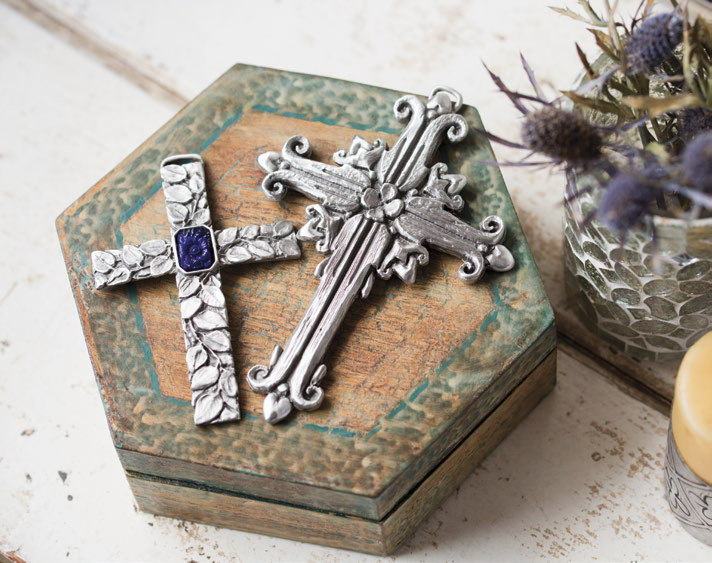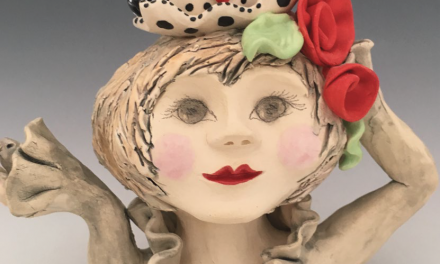- Cynthia Webb Designs
- Cynthia Webb San Diego, Calif.
- Website: http://cynthiawebbdesigns.com/
Stubborn, naïve, and green, artist Cynthia Webb dove headfirst into the handmade world over 25 years ago. “I truly had no idea what I was doing. I say that and folks don’t believe me,” Webb says. “I am simply stubborn. When I first started, I didn’t have a real point of view; I simply did what matched my aesthetic.”
Fortunately, Webb says her shotgun approach churned out some instant hits: “I have a Three Sisters piece that was sort of my one-trick pony that helped pay the bills while I learned and created more pieces that worked with my strengths.”
The architect-turned artist works in pewter; she creates an original piece out of jeweler’s wax. She designs her own pieces; some are historical design adaptations. Sometimes her husband and son assist with design creation. The molds she crafts can be used hundreds of times, as she uses a durable vulcanized rubber.

Her architecture-entrepreneurial shift
Webb made the shift from architect to artist but did so willingly and with heart. “My husband was an architect,” she says. “We always joked that having two people in a family in architecture was at least one too many. It is sort of a feast or famine industry.”
Years ago, while on maternity leave, Webb had some time to look around at other career options. She had taken many jewelry classes at Chautauqua and even took a class in London when she was between high school and college. “It was really an absurd ‘I can do that’ moment when I was at the Ann Arbor Art Festival when I saw a pewter artist with really whimsical work. He was selling like crazy. A woman from the San Francisco Ballet asked about wholesale prices for a piece; he had more than a 3x mark-up.”
Webb says that finding her own voice in the marketplace was really important. “When you start it is too easy to see this person selling well with this or that, and you think you should follow suit. My focus is family, spirituality, nature, and home — and that is why I can sell. I can’t sell funny.”
Developing a customer base
What Webb does create sells really well and she has built up a loyal and steady following. “My work is not bright — pewter is quiet. I am not contemporary, nor am I really traditional. I joke that I am the ‘other white meat’ in the art world,” she says.
The artist recalls a time when she has had some of her best wholesale customers take her work, practically kicking and screaming, saying their customers would never buy any of her work. “I am in no way edgy,” she smiles. With a mid-range price point, her work appeals to a wide audience. “I am not cheap, but for some galleries I seem too low.”
She says she offers a satisfaction guarantee and will swap out products for a better fit when needed. “They sometimes have to see it at a show a few times before they will order — and understanding that is important,” explains Webb.
Staying true to her ideas
Some of Cynthia Webb Designs best-selling items are “The Perfect Union,” which is a tree of life motif with doves. “Bird’s Nest” is her best-selling framed piece. “I love that piece,” says Webb. “I look at that bird as a reflection of nature. My grandmother loved birds, and I had long collected fallen bird nests. We had an aviary for years that had tiny finches. Nature always astounds me. So, I see it as a new birth … renewal … spring. A lot of folks are now looking at it as a reflection of their own family and want the number of eggs to match the number of children or grandchildren they have. People also love the three dimensionality of it in the frame.”

When the going gets rough
Webb admits she was faced with more than a few challenges when starting up her handmade business. “I had no idea about bookkeeping, finances, and money,” she says. “I had no clue on margins, pricing, costs, and how to log it all. A friend who was an accountant came over to help me and just started laughing out loud when he saw what I was doing. I became very adept at QuickBooks in a short time.”
She has also endured other battles in her personal life that have affected her tremendously. “I was married for almost 30 years; my husband passed away in 2012 after a brief, but aggressive battle with prostate cancer,” she says. She says her sons are both artistic and are also trying to find their own way in the art world, “which means they are underemployed in L.A.”
What continues to draw Webb into her work is learning about the personal stories of how her pieces end up being someone’s favorite wedding gift or when customers get teary-eyed as they recount an event or a person that her work reminds them of. “Or, someone who gave one of my pieces to their wife to take to the hospital while she received cancer treatments. It sounds totally sappy and it is. I sell sentiment — feelings, and we share those feeling,” she explains. “You don’t get that from selling a mindless widget. That really feeds me.

Cynthia’s Words to the Wise
- Find your own voice; be your own perspective
- Don’t worry about what everyone else is doing.
- Really flesh out who your customers are.
- Find a mentor or join a support group with other artists.
- Don’t copy other artists’ work; there are only so many ideas out there but make it yours.
- If you believe in a piece and it doesn’t sell, try to look at it in a different way — experiment.







